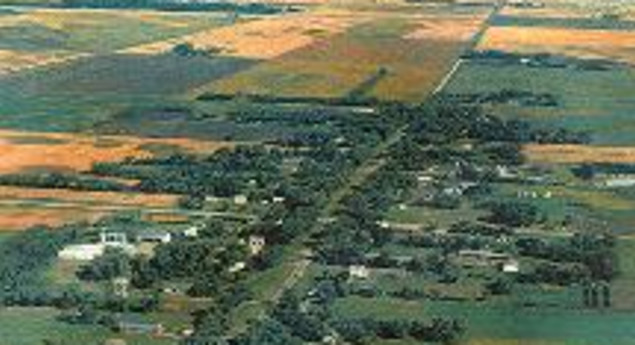DESCRIPTION OF HISTORIC PLACE
Neubergthal Street Village National Historic Site of Canada was founded in 1876 by a group of related Mennonite families on the open plains of southern Manitoba. The village is now surrounded by flat farmland. The community occupies six sections of land where residences, farmyards, and communally owned arable fields and pasturelands are arranged in long narrow farmsteads. The farmsteads that form the village are positioned in traditional fashion behind fencing along a single tree-lined street, creating a distinct identity. Official recognition refers to the street village on the block of six sections of land.
HERITAGE VALUE
Neubergthal Street Village was designated a national historic site of Canada in 1989 because:
- Mennonite Street Villages are Prairie settlement forms of both national historic and architectural significance and they are commemorated at New Bergthal, Manitoba, which not only possesses a considerable amount of resource integrity but an apparently unique “sense of place”.
Neubergthal Street Village is a living illustration of a Mennonite village on the Canadian Prairies. Its heritage value rests in the distinctive settlement forms resulting from Mennonite traditions of community development and architectural forms that express a belief in an egalitarian, communal and self-sufficient social structure. A group of related families, the children of Johann and Margaretha Klippenstein, founded the village in 1876. They settled on land, which, together with some additional families, they entered as homesteads between 1876 through the 1880s. The street village formation was a good model for settlement because it required close interaction and cooperation among residents. Villagers assisted each other with harvesting and threshing, butchering and building. The church, as the central institution of village life, defined how they made their living, governed themselves, and generally defined their values and behaviour.
Sources: Historic Sites and Monuments Board of Canada, Minutes, February 1989; Commemorative Integrity Statement, 1998.
CHARACTER-DEFINING ELEMENTS
Key elements that define the heritage character of this site include:
- the single street providing the central orienting spine of the village defined by a straight row of planted trees and fencing;
- the low massing of the distinctive long, narrow farmsteads aligned side by side, perpendicular to the street;
- the distinctive arrangement of lots with housebarns set back from the street at about 24 metres (80 feet) and constructed at right angles to it on the north side of the driveway with the main door facing south and outbuildings arranged to side and rear of each lot;
- the flower gardens, fruit orchards, vegetable gardens and tree gardens spaced on yards in a pattern with trees at the front, and vegetables at the back;
- the remnants of open village farm lands divided into arable, planted lots and grazing lots arranged in narrow strips of about 4-6 hectares (10-15 acres) defined by narrow strips of uncultivated land between each field;
- the distinctive architectural types, including homes with a connected housebarn and a herdsman’s house;
- the evolved house type separate from but close to the barn in a generally similar placement;
- the houses characterized by a distinctive pattern of fenestration with four or five windows of equal size on each side and two at the end, the exterior wooden shutters of standard design, and the layout of rooms arranged in a horse-shoe pattern around a central brick stove-heater;
- the attached, multifunctional barns characterized by a central aisle running the length of the barn from the door into the house to the door at the opposite end, the stalls for livestock on each side of the aisle, the large open area for grain storage and threshing, the double doors on the side with diamond-shaped designs on the outside, the exterior door with divided top and bottom sections (Dutch door) and the row of small windows along the front side;
- the distinctive barn-building techniques evident in the log structural frame, dovetailed beams and joists, ornate lap-notch joinery and wooden pegs on the sway braces.
Earn 10 points!









